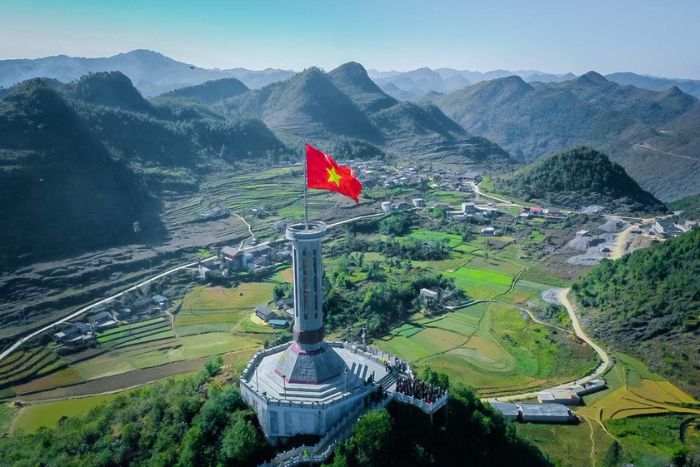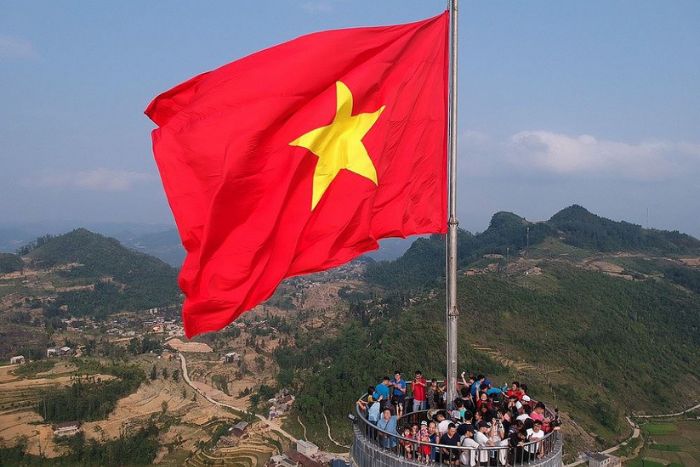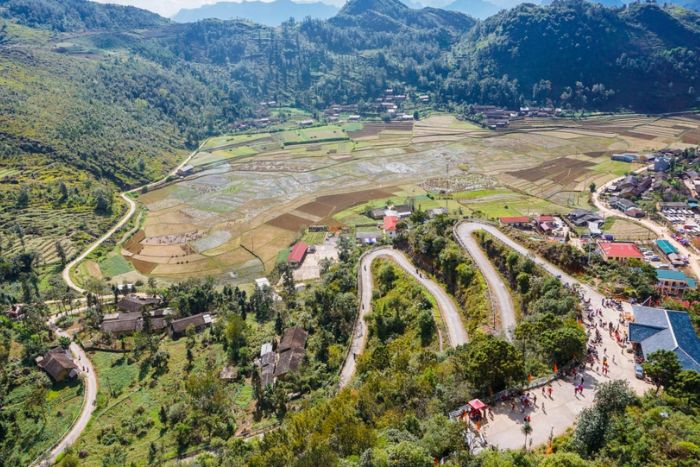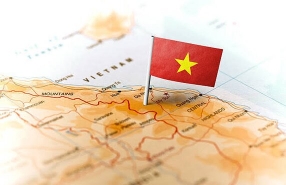Visit The Lung Cu Flag Point - Historical And Sacred Symbol Of Ha Giang

While exploring Ha Giang Loop in northern Vietnam, Lung Cu Flag Point is one of the must-see tourist attractions and is considered one of the emblematic symbols of this province. Additionally, Lung Cu Flag Tower is a source of pride for the Vietnamese nation, marking the territory of this Southeast Asian country. Let’s discover together why the Lung Cu Flagpole in Ha Giang attracts so many visitors!
Table of Contents
I. Where is Lung Cu Flag Point?
Lung Cu Flag Point (Vietnamese name: Lũng Cú) is located at Lung Cu Peak, also known as Dragon Peak, in Lung Cu Commune, Dong Van District, Ha Giang Province, Vietnam.
Situated at an altitude of 1,470 meters above sea level, Lung Cu Flag Tower is a symbol affirming the territorial sovereignty of northern Vietnam.
During your trip to Ha Giang, you must not miss Lung Cu Flag Point, as it is a sacred historical monument for the Vietnamese people in general, the inhabitants of Ha Giang in particular, and especially a source of pride for the ethnic minorities of northern Vietnam.

II. History of Lung Cu Flag Tower
Lung Cu Flag Point in Ha Giang was originally constructed during the Ly Dynasty using trees. According to historical records, when Ly Thuong Kiet was defending the border in the Lung Cu region of Ha Giang, he planted the flag at the peak of Dragon to assert Vietnamese territory.
In 1887, the French undertook its reconstruction. Later, in the years 1992, 2000, and particularly in 2002, this flag point was restored several times, with increasing dimensions and scale over time.
Notably, in 2002, Lung Cu Flag Point was erected to a height of about 20 meters. Its base had a hexagonal shape, and bronze drum motifs of Dong Son were carved at the base. Additionally, at the top of the flag point was a 9-meter-tall flagpole, bearing the Vietnamese national flag measuring 9 meters long by 6 meters wide, with a total area of 54 square meters.
It wasn't until 2010 that Ha Giang Provincial People's Committee Province began the reconstruction and renovation of Lung Cu Flag Tower to give it an octagonal shape, with a height of more than 30 meters. The new flag point was inaugurated on September 25, 2010.

III. Entrance ticket for Lung Cu Flag Point
- Entrance ticket:
Adults: 25,000 VND/ticket
Children under 1.3 m: Free
- Electric Car Ticket:
Adults: 15,000 VND/ticket
Children under 5 years: Free
- Parking Fee: 10,000 VND/session
IV. How to get to Lung Cu Flag Point?
Lung Cu Flag Tower is located at the top of Dragon Mountain. The path from the foot of the mountain to the Lung Cu Flag Point consists of a total of 839 steps. The journey to the top is divided into three stages. At each stage, there are rest areas where visitors can relax and enjoy the scenery.
From the foot of the mountain, you will see Lung Cu Flag Point at the summit, with the red flag of Vietnam fluttering in the wind. Additionally, as you ascend the stone steps, you can admire the majestic nature of Dong Van Karst Plateau.
The higher you go, the more mystical the Ha Giang landscape becomes, as if immersed in a sea of clouds. You will have the unique experience of standing at the highest point in Northern Vietnam and touching the sacred Lung Cu Flag Tower after climbing this long series of steps.
V. What to Do at Lung Cu Flag Point?
1. Admire the Vietnamese flag waving
After a journey of 839 steps, you will reach Lung Cu Flag Point, the highest point in the far north of Vietnam. This place is ideal for taking magnificent photos. Additionally, it is a significant symbol of Vietnam's strong territorial sovereignty.
Furthermore, from the top of the Dragon, you can admire the majestic landscape of the surrounding nature, from terraced rice fields to ethnic villages.

2. Cross Lung Cu winding passes
To reach Lung Cu Flag Point, you will have to traverse winding passes that snake along the mountainsides. If you are a thrill-seeker, these passes will be an unforgettable experience for you.
You will be able to immerse yourself in the nature of Ha Giang. You will pass through terraced rice fields, discover flower fields on the limestone plateau, and meet smiling locals who always greet visitors to this region.

3. Visit Dong Van Ancient Town
Next to Lung Cu Flag Point, Dong Van Town is also a destination not to be missed. It is a place that still retains many cultural characteristics and ancient customs of the local ethnic groups for you to discover.
As you walk through the town, you will encounter ancient houses that are hundreds of years old. All the houses are planned and built side by side, forming a row with the same traditional architectural style of the local inhabitants.
By visiting these ancient houses, you can learn more about the history and culture of Dong Van Town and taste local specialties directly at Dong Van market.

4. Discover Quan Ba district in Ha Giang
Quan Ba is the next destination on your Ha Giang journey, after visiting Lung Cu Flag Point. Quan Ba district also has many attractive tourist sites such as Lung Khuy Cave, Nam Dam Village of the Dao ethnic group, Quan Ba Heaven Gate and Quan Ba Twin Mountain, etc. This place stands out not only for its cultural richness and the customs of ethnic minorities but also for its beautiful natural landscapes.

In conclusion, Lung Cu Flag Point is not only a symbol affirming the territory of Vietnam but also a symbol of the indomitable spirit, strong will, and determination of ethnic people in Ha Giang province. If you are planning to travel to Ha Giang soon, please contact Autour Asia, your Vietnam travel company, so that our travel experts can quickly help you create a personalized itinerary for your trip to Vietnam.
> Things to do in Ha Giang
> Ha Giang Travel Guide
> Vietnam north tour
> 12 days in northern Vietnam
The Hoang Su Phi rice terraces and Ho Thau rice terraces are the best rice terraces in Ha Giang from my perspective. Both places have beautiful views and let you experience local culture.
The Lung Cu Flag Point is open from 08:00 to 17:00 every day, Monday to Sunday. The best time to visit is from August to October. You can see the rice terraces during the ripe rice season.
Related travel guide
Other similar articles
CUSTOMIZABLE BY LOCAL EXPERTS
Personalized trip at the original price!
REFUND GUARANTEE
We believe in our work and promise to give you money back.
GOOD PRICE / QUALITY
95% satisfied more than expected!
24/7 LOCAL SUPPORT
We are always available online to provide assistance at any time.
Most read articles
Autour Asia is highly recommended on
Embracing the mission of "Satisfied more than expected" and providing authentic experiences, we have received numerous recommendations on reputable travel forums:























